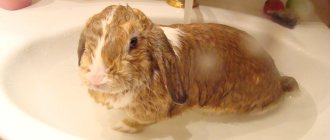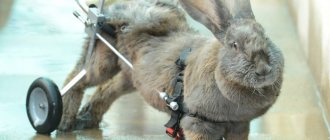Those who are going to get a rabbit for home keeping, for example, inside the walls of an apartment, immediately ask themselves the question: how to train a rabbit to use a tray. Experienced rabbit owners have accumulated considerable experience on this topic over many years, which we hasten to share in this article.
How to litter train a rabbit
Prices for toilet tray
Toilet tray
Important points
Don't expect your newly purchased little rabbit to use the litter box from day one. Rabbits that have reached sexual maturity are much more effective at learning to be clean. Let's look at the reasons in more detail.
Castration of rabbits is the key to visiting the tray
It is easiest to train adult, neutered rabbits to use a litter tray. Since it is prohibited to sterilize immature rabbits, new rabbit breeders will have to put up with the frequent visits of their charges to the toilet past the tray.
Puberty in rabbits occurs at 3 months of age. During this period, castration is performed, otherwise the rabbit will never go to the tray. Having managed to mark the corners of the apartment with urine containing a special, foul-smelling secretion, he will defecate randomly, leaving stinking puddles throughout your home.
Neutered rabbits are more likely to visit the litter box
Caecotrophs - food element for rabbits
Some owners notice that a rabbit that regularly visits the tray continues to empty its intestines inside the cage. Do not rush to remove this feces, your pet receives useful substances with it!
Caecotrophs are necessary for rabbits to provide adequate nutrition.
Take a close look at your ward. During the day he goes to the toilet in dry, dense peas. This droppings contain waste, fibers that the rabbit could not digest, and other harmful waste. But at night, the long-eared droppings look different: they have an oblong shape, are covered with mucus, the balls are glued together in clusters, and they give off a very specific smell. These droppings are called caecotrophs. The rabbit produces it primarily at night, which is why slimy peas are also called night peas or primary peas.
Caecotrophs in the rabbit's body
Is a rabbit clean by nature?
To quickly and effectively teach your child to use the litter box, you should understand the nature of his cleanliness and find out how he goes to the toilet in his natural environment.
Many underground animals urinate and deposit droppings in the same places where they sleep and eat, that is, in their burrows. Unlike its own kind, the rabbit defecates exclusively outside the burrow. Despite the rapid digestion, this animal waits the time necessary for a foray and does toilet chores while searching for food. There is a phenomenon called “rabbit toilet”. It denotes characteristic piles of droppings located a couple of meters from the long-eared house. If you step into it, have no doubt that there is a rabbit hole somewhere here.
If you see caecotrophs in a cage, do not remove them under any circumstances.
In the wild, the rabbit defecates without leaving the burrow, but eats the balls directly as it exits the anus.
Suitable age for training
You can toilet train a decorative rabbit from the moment it appears in the house. It is worth remembering that rabbits at 3-4 weeks, although they look independent, at this age they should not be taken away from their mother and they should not develop toilet behavior. This is due to the fact that young animals of this age are very vulnerable. He can die from the slightest errors in care.
It is incredibly difficult, almost impossible, to potty train an adult animal. Such rabbits have already developed a stereotype of behavior, and they will fulfill their physiological needs wherever they want. When choosing a pet for your home, it is better to opt for rabbits 45-60 days old. They develop new skills the fastest. Animals no older than 3-4 months can be easily toilet trained.
Why does a rabbit refuse to go into a prepared tray?
There may be several reasons:
- an uncastrated male marks territory;
- the tray is too small for a fluffy one;
- the rabbit does not like the consistency or smell of the litter;
- improperly organized space inside the cage or for the tray.
Let's look at each reason in more detail.
A rabbit can turn up its nose at the litter tray for various reasons.
An uncastrated male marks his territory
We discussed the first case. It is recommended to castrate a rabbit kept in an apartment, just before puberty, without allowing it to begin marking its territory.
Castration of an animal will help solve the problem with visiting the tray
Tight tray
A small tray will be a real test for the ward. The process of rabbits going to the toilet requires a certain comfort, just like a person, and it’s hard for a rabbit in cramped conditions.
A cramped litter box may cause refusal to use a toilet.
Unsuitable filler
You will have to select a different filler for the tray if the long-eared one flatly refuses to go into the one purchased by a caring owner, otherwise keep a rag ready for washing the floors 24 hours a day.
These whims of animals are caused by associations that a person cannot understand, however, you will have to make concessions to your pet so as not to constantly risk stepping into a puddle of urine or a pile of droppings.
The convenience and beauty of the tray will not attract a rabbit if there is filler inside that is unpleasant for the animal
Improperly organized space
Let us note one interesting feature. As mentioned above, rabbits go to the toilet while eating. They have developed this instinct over many generations. If you don’t throw at least a little hay next to the tray, the fluffy one is unlikely to be interested in cultural trips to the toilet.
An original idea for a toilet for rabbits with a compartment for hay
Don't worry about having to install the litter box directly into the cage. Although it represents a home for the animal, it is not a burrow. Monitor your pet's behavior carefully and over time you will understand why your long-eared pet feels uncomfortable in the litter tray.
Below we will take a closer look at how to accustom a rabbit to a litter tray by creating ideal conditions for it.
Stage No. 1 - selecting the right tray
You should not look in pet stores for trays designed specifically for rabbits. An ordinary cat litter box is ideal for your pet. Believe me, a smaller tray will be uncomfortable for a rabbit to use. Therefore, if after installing the tray there is too little space left for the animal to live, then the owners were greedy and gave the furry one an insufficiently spacious home.
A cat litter box is suitable as a toilet for rabbits
There are modifications of trays in the form of corner products. They are better suited for rabbits, because they take up minimal space. However, do not buy a tiny toilet; the animal should be comfortable in it.
Which tray to choose
How quickly you can train your pet to use the toilet depends on how correctly the tray is selected. It should be comfortable and convenient. The animal must not only fit completely in it, but also be able to move around.
How to train a toy terrier to “walk” on a diaper
There are two types of trays you can purchase at a pet store:
- corner - it is best suited for cells of small size and rectangular shape;
- rectangular - for indoor fences or spacious cages.
The design of the tray should include a mesh and a removable grid. Externally, the device resembles a cat litter box. Its tasks are to provide the animal with comfort and also ensure the necessary level of hygiene.
Advice! You can use a homemade tray made from plastic containers. It is important that it has low sides that are comfortable for the pet.
The tray should first of all be spacious
Stage No. 2 – the process of accustoming
Carefully read all the elements of the training process described below and implement them without skipping a single one.
Help your pet get used to the litter box using the instructions in this article.
cage fencing
At first, do not let your pet wander around the entire apartment, as for him it will become a wild environment in which he can not only chew something, but also empty his intestines. Fence a small area around the cage for the first time so that your pet understands where to go to the toilet correctly.
When you realize that your rabbit has become accustomed to the litter box, expand or remove the fence. Monitor its movements throughout the week, as the animal may begin to mark past the tray, even knowing its purpose.
Protect your rabbit from a small area of your home for the first time.
Punish the rabbit who has committed a bad act by re-fencing the area. You can poke it near the mark on the carpet, but carefully so as not to harm the pet’s health.
Physical punishment of animals has a significant disadvantage that repels supporters of this method of education: a rabbit that has received serious stress will begin to go to the toilet randomly and will continue this behavior for a long time, even inside its cage.
Prices for cages for rabbits
Rabbit cage
Multiple litter boxes throughout the house
A rabbit released from behind a fence will better understand the need to visit the litter box if there are several of them in all corners of the apartment. The smell from the toilets will attract the animal, no matter what part of the house it is in. Do not forget to clean each toilet in a timely manner, otherwise the animal will not want to go there.
Install several trays around the perimeter of the apartment
Install trays in secluded, darkened corners of the apartment. Eared cats, like cats, love to relieve themselves there, feeling safe and comfortable.
After some time, your pet will decide which of the trays he likes best. Then calmly remove the excess, after thoroughly washing and disinfecting.
Rules for using filler
There are several important rules regarding handling filler.
Rule #1 - do not use litter as bedding.
The rabbit gets used to feeling the litter under its paws exclusively in the tray. If you start pouring absorbent crumbs into the bottom of the cage, the confused animal will begin to perceive it as a tray.
Separate the living space from the litter box by adding bedding to the bottom of the cage. For example, soft straw will create extraordinary comfort for the animal, allowing it to create burrows in it and it will not want to soil the bedding with feces and urine.
You cannot use the same filler as bedding as in the tray.
Rule No. 2 – choose a filler that is pleasant to the animal
When choosing a filler, give preference to options made from compressed or ordinary sawdust. Such natural material will help recreate conditions close to natural for your pet.
It may also happen that the fluffy will like the mineral filler. This is also good, since its absorbent properties are better than those of sawdust. Don’t be afraid to change the fillers, let the animal try new options and find one that’s comfortable.
Sawdust is the best filler option
Rule No. 3 - do not change the filler often at the beginning of the process of getting used to the tray
A rule that must be followed. A strong smell should form in your pet's litter box, reminding him where to go to the toilet. Even though after washing the owner's scent tray it is not noticeable, the animal perfectly senses the amber.
Don't change the filler too often
Filler selection
At the pet store you will probably find special trays for eared animals. One side of them is lower than the others. It is convenient for a pet fluffy to climb into such a tray. But the compact design with fastenings is suitable only for a miniature decorative rabbit living in a cage. Representatives of other breeds will feel cramped in such a container.
To toilet train a rabbit, you will need a spacious container. For example, a tray for cats. You must first remove the mesh from it. If, after installing the toilet, you find that the rodent has little free space left, it means that initially its “living space” did not meet the necessary requirements.
Advice. The container should not have sharp edges. Do not choose metal models - it will be uncomfortable for the rodent to stand on a cold tray.
Rabbit litter is also important. When choosing, follow these recommendations:
- when buying a finished product, make sure that it does not contain artificial flavors and dyes;
- the best option is sawdust from deciduous trees, since they absorb rodent waste products well and do not injure its delicate paws;
- An alternative to wood shavings will be clean paper;
- newspapers are not suitable because of the printing ink, because curious animals can taste newspaper scraps;
- for the same reason, buying cat litter would not be the best solution: rabbits can be poisoned by the granules.
If sawdust is not available, it can be replaced with hay or straw. As a last resort, use torn colorless paper. There should be no inscriptions or other colors on it.
We invite you to familiarize yourself with Rabbit in the apartment, the secrets of breeding rabbits in the apartment
The choice of litter box is a very important factor when toilet training your rabbit. He should like the tray. Under no circumstances should this container be used for educational purposes or as a territory for punishment. The container should have low walls so that it is convenient for the baby rabbit to go to the toilet and get accustomed to this place.
Their prices are very affordable. The tray can be of any shape, the main thing is that the animal can fit comfortably in it. There should be a special hook on the closet, with the help of which the litter box is attached to the wall and does not turn over when the rabbit tries to get used to going to it to relieve its needs.
The rabbit should like the tray
Also, special attention should be paid to the choice of filler for the tray. It should be taken into account that the animal may try to eat the filler, so it should consist of environmentally friendly materials
In specialized stores you can find granular filler, which is compressed sawdust. This filler perfectly absorbs unpleasant odors, does not cause harm to health, and is easy to clean up if accidentally consumed.
Both paper and sawdust can be used as filler. This is a cheaper filler option. Thanks to the grid that is present in the trays, the animal will not be able to drag the paper around the home. Paper absorbs urine well; the only disadvantage of this filler is that it absorbs odors with difficulty. Therefore, it needs to be changed after each trip to the toilet.
Stage No. 3 - remembering the tray by collecting litter
After you bring your small pet home and place it in a cage, regularly inspect its movement area for droppings. Carefully collect the peas lying outside the tray and place them in it.
Collect rabbit pellets around the apartment and put them in a tray
If you got a new pet due to the death of the previous one and you happen to have the feces of the previous resident lying around the house, put them in the tray of the new one. The long-eared cat will instantly begin to cover other people's pellets with its droppings and, by inertia, will get used to the tray.
Stage No. 4 - remembering the tray through regular sitting
Accustom your rabbit to the tray by placing it in the tray every 10-15 minutes of walking around the apartment. When your pet goes to the toilet, reward him with a treat.
If you notice that the rabbit has gone to the toilet by, immediately place it in the litter tray. He will have associations with bowel movements in any case, especially if they are reinforced with food.
Reinforcement of action by voice
Reinforce when placing the rabbit on the potty in a stern voice. Repeat the same words, encouraging the animal to do its job correctly. For example, say “go to the toilet.” Make the tone of your voice stern, but not angry, as the animal will be scared and will not come close to the pot.
It is important to reinforce the process of sitting on the tray with your voice
Walking schedule
After the pet has dined on food, do not let it out for a walk around the apartment, keep it in a cage near the tray, preferably with a partially full litter. Let the animal go for a walk first in the morning, before breakfast, and in the evening, until it receives dinner.
Let your rabbits out for walks only at certain times.
Don't worry about not being able to get the animal to return to its cage after traveling around the apartment. If you teach your cat to follow a schedule, he will rush into the cage to quickly get a delicious breakfast or dinner.
We present a table of proper feeding and walking of long-eared pets.
| Morning | Day | Evening | |
| Feeding | Food is provided after walks | Feeding is done at lunchtime at the same time | Food is given in the evening, or at least at night |
| Walk | Produced before feeding | Walks after and before lunch are excluded | The walk is done in the evening, before feeding |
Video - How to litter train a rabbit
Some useful tips
- Before buying an animal, find out where the previous owner had a tray. Ask for dirty litter as a gift, you will need it for training. By placing the toilet in a similar place, the pet will feel a familiar smell there. In the future, he will use the pot for its intended purpose. Do not forget to regularly, at least in the morning and evening, collect peas and urine that are outside the tray and transfer them to the tray.
- Clean the tray and change the litter regularly. At first, leave a small part of the old one for the smell. This will be a hint for your pet. If you do not change the litter for more than a week, the pet will stop going to the installed toilet. The pet will perceive the presence of sawdust next to the pot as an extension of the toilet. It’s better not to let it get to this point.
- Pour the litter exclusively into the tray, and not throughout the enclosure.
- Sometimes a rabbit deliberately does not go to the litter tray and chooses another place for the toilet. To cope with this, it is enough to place another device in a new place. Over time, you can remove the second pot.
- When letting your rabbit out for a walk, place it in the tray every 10 minutes so that the animal develops a reflex.
- When you let a rabbit out for a walk around the apartment, it is better to make the bed, since even a toilet-trained rabbit can go to the bed, since it smells like you, and rabbits are territorial animals, thereby trying to conquer the territory and show that it is his.
- Animals learn from their parents, and you will immediately know whether the breeder trained his rabbits to use a tray - your pet will do as his mother and father did. You are lucky if you buy a litter trained rabbit.
- The decorative rabbit does not perceive it when its nose is poked at its ugliness. The correct thing to do would be to sternly shout at your pet and lightly slap him on the butt. Only very lightly, so as not to offend your eared friend.
Tray training using the example of the older generation
By buying a friend for an adult rabbit, you can forget about the problems associated with litter box training. Your first pet will cope with this by clearly showing the newcomer where to go to the toilet.
The competition factor will also play a significant role. When visiting one tray, rabbits will try to cover each other's droppings with their own.
Rabbits are litter trained, following the example of their brothers
What to do if a rabbit goes to sleep in a tray
This circumstance will become a problem only for owners who rarely clean their pet’s cage. If you are not one of them, don’t worry, just clean the litter box after each time your pet uses the toilet.
Of course, this problem should not be left to chance. When spending the night in the litter box, the rabbit gives a signal that it is uncomfortable for him to sleep in the cage. Perhaps the cage is too small and the tray takes up most of the floor. Insufficiently soft or very dirty bedding can also cause refusal to fall asleep in the right place. Watch the fluffy one and you will understand what exactly the situation is.
Your pet should be weaned from sleeping in the litter box
How to fill the tray
The toilet is installed, now you need to pour filler into the tray. Any filler for rodents (pressed sawdust) or cats will do. Please note once again that the sawdust should be pressed in the form of granules, and not the kind that can be collected at a sawmill.
Pour the litter only into the tray, otherwise your decorative pet will think that the toilet is everywhere, and you won’t be able to train him to go to the corner. For the first time, you can lay a piece of fabric in the living part of the cage; it will make it easier to shake off the poop into the tray.
What to do if a rabbit goes to the toilet next to the litter box
Many rabbit owners are faced with a situation where their pet goes to the toilet regularly, a centimeter from the tray. The reasons for this behavior may include the following:
- low sides of the tray;
- a large amount of filler inside the toilet.
Both of these circumstances bring serious discomfort to the animal. Correct them, and he will sit inside the tray more willingly.
The pet goes to the toilet next to the litter box because it feels uncomfortable
Why did a litter-trained rabbit stop going in it?
Let's take a closer look at the possible causes of the riot.
Puberty
As mentioned above, at the age of 3 months, male rabbits become sexually mature and begin to mark their territory. The only salvation in this situation is castration by a veterinarian. However, the rabbit will continue to mark its territory afterwards, but in a different way: the animal will rub its neck against the edges of the cage and other objects, leaving the smell of the skin on them. Spraying castrated rabbits with urine will not have the desired effect, since there is no longer any smelling secretion in it.
Don't expect random urine spraying to go away immediately after surgery. You should wait a month and a half. After this period of time, the first progress is usually observed.
Puberty pushes the rabbit to rebel against the litter box
The appearance of a new animal
For the animal, the appearance of a competitor will not only be stressful, but also a threat to its sole ownership of the territory. Of course, over time the animals will become friends, but at first the older rabbit will try to saturate the home as much as possible with its scent in order to cover up the smell of the stranger.
The appearance of a second pet will make the rabbit worry
Reasonless riot
In fact, there is always a reason, but people are not always able to understand the signs that the animal gives. Start by having your pet examined by a veterinarian. If there are no diseases, then try repeating the process of accustoming your pet to the tray again to refresh his memory.
Stressful situation
Domestic rabbits are very sensitive animals. Any minor event can make them worry, for example:
- arrival of guests;
- the appearance of strange animals in the house;
- being picked up by a stranger;
- moving;
- the emergence of new areas for walking.
Listen to your pet's problems and desires and facilitate the process of litter box training
After refusing to use the litter box, begin to carefully monitor your pet. It is easier to eliminate the cause if you know what exactly to disturb your pet.
Learn to reward or punish your pet in a timely manner. By guessing where the whims are and where the real discomfort is, you will brighten up the sad times of your furry friend with a treat, or, on the contrary, stimulate him to obey with the help of a menacing voice.
Prohibited tricks
The techniques described in this section should not be used on rabbits, as they are inhumane and absolutely useless. For example, it is strictly contraindicated to lock an animal in a cage for a long time. This freedom-loving animal will not only mark its owner as an enemy forever, but can also die of boredom in a short time. Instead of this cruelty, simply limit the rabbit's walking area.
A truncated area for walking will help you push your pet to the tray in time. The natural cleanliness of the animal will not allow it to pollute a small area of its residence, and it will try to hit the target.
Corner litter box - a convenient variation of the rabbit litter box
If you see that the rabbit is going to do business in the wrong place, do not hit the animal. The fragile body of the animal is easy to injure, and besides, it will lead nowhere. Repeat in a menacing voice “go to the toilet,” “you can’t,” or even “ugh.” Transfer the animal, which is indifferent to commands, to the tray yourself, continuing to repeat the cherished phrases.
Is it possible to toilet train a rabbit?
It is not only possible, but also necessary, to potty train a rabbit living in an apartment. Before you begin training, you need to find out some information about the life of long-eared animals in the wild. In their natural habitat, rabbits live in burrows and do not create a special place for a toilet in them. If they need to relieve themselves, they simply leave the confines of their home.
Once in a home environment, a rabbit perceives its cage or enclosure as a burrow. Your apartment for him is a space outside the home. Therefore, it is not surprising that he marks his territory around the hole. Based on this, you need to properly work out a plan for potty training your pet.











